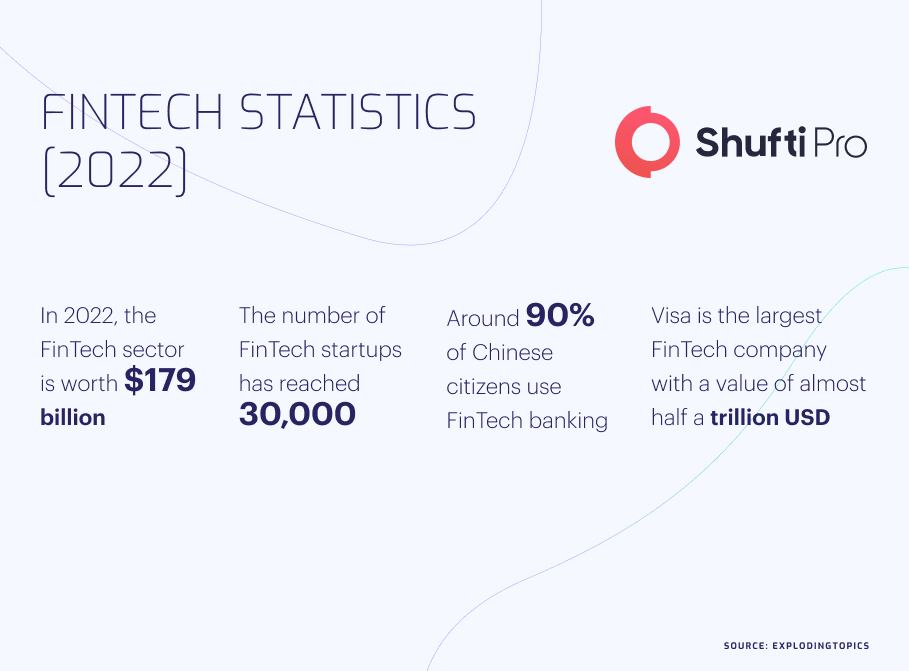AML Compliance – Eliminating Financial Crimes in FinTech Firms

The FinTech industry is growing rapidly across various sectors with investments and large-scale adoption with an increased focus on Anti-Money Laundering (AML) compliance. The global FinTech industry has grown by 97% since 2017 when its revenue was approximately $90.5 billion and is expected to grow to more than €188 billion by 2024.
The success factors of the FinTech industry are its defined direction and innovations in every subsidiary sector for financial operations, which have brought success for stand-alone businesses as well as interlinked financial chains. FinTech companies have also revamped customer expectations by setting new standards for convenience in the provision of financial services.
The Role of AML in the FinTech Industry
Anti-Money Laundering (AML) regulations are defined by financial authorities to clamp down on financial crimes like money laundering and terrorist financing. In the traditional banking sector, AML compliance has been a compulsory measure for quite some time. Similarly, the FinTech industry needs AML regulations to maintain a crime-free system that doesn’t allow the flow of illicit funds. Businesses operating in the financial sector, like FinTech firms, investment firms, insurance companies, credit unions, and even crypto firms face the concerns of balancing between AML compliance, operating costs, and fraud risks.
In the US, there have been many updates and amendments to the Bank Secrecy Act (BSA) of 1970. The US government demonstrated efforts to tighten AML regulations during and after the pandemic. The amendments in regulations were needed due to the increased cases of money laundering using new and sophisticated methods. Even after the introduction of regulations, wealthy politicians and Russian business tycoons get away with hiding their illegally-obtained funds.
FinTech companies and other institutions dealing with monetary processes in the US are regulated by the Financial Crimes Enforcement Network (FinCEN), the Securities and Exchange Commission (SEC), and the Commodity Futures Trading Commission (CFTC), along with other state regulators. Similarly, in the UK, the Financial Conduct Authority (FCA) is responsible for regulating the FinTech sector and other financial institutions. Paris-based AML watchdog, the Financial Action Task Force (FATF) oversees the global financial landscape and points out the countries that fail to implement stringent measures for combating financial crimes.

Benefits of AML Compliance in FinTech Firms
Like any business dealing with financial processes, FinTech firms also face the risk of unwillingly sourcing a money laundering scheme. Considering the consequences of becoming part of such a scheme, FinTech companies take steps to develop a fraud-free system. By law, FinTech firms are obliged to monitor the transactions and account activities of their customers, identify anomalies, and report suspicious activities to the relevant authorities.
Implementing sufficient measures for AML compliance requires FinTech firms to consider various factors, including the effect on conversion rates, the speed of transaction processing, and irregular warnings of suspicious activities. One of the biggest reasons why FinTech firms shy away from incorporating an effective AML program is the decrease in conversion rates. In the beginning, stringent AML screening forces some of the customers to abandon the company due to the requirement of sharing personal information.
In the presence of an effective AML screening system, FinTech companies will take more time to onboard new customers, making it less convenient for them to complete the whole process. In addition to slow onboarding, stringent AML checks are also said to make the log-in process longer with additional security steps like 2 Factor Authentication. That being said, Shufti’s automated AML solutions provide FinTech firms with instant verification results without the hassle of manual checks.
The Trade-off Between Security & Convenience
Even when the onboarding and log-ins are sorted, FinTech companies are also faced with the dilemma of transaction processing. In the presence of AML transaction monitoring protocols, FinTech customers are said to experience slower transaction speeds because of the added authentication layers. Even though this is considered a disadvantage, it does help prevent financial crimes. For instance, money launderers can easily take advantage of a fast transaction to process a large amount of illegal money and convert it into legal cash.
The slower process for legitimate customers is actually an effective measure that stops financial criminals in their tracks. FinTech companies struggle to develop the ideal system to deal with the scrutiny from governments and law enforcement agencies throughout the world, as well as combating money launderers. On top of that, AML regulations are not the same in every part of the world, making it difficult for in-house compliance teams to cope when they open an office in a new location. Non-compliance is never an option for FinTech startups as it results in hefty penalties and in some cases leads the business to bankruptcy.
KYC for FinTech Companies
The basic step in any AML compliance program is KYC (Know Your Customer) verification. AML regulations oblige FinTech companies to adopt a risk-based approach to tackle financial crime, meaning they should implement measures to verify the identity of their customers during onboarding. Before the new customer can actually access the system and perform transactions, the business must be sure that they are a legitimate entity, not a financial criminal trying to launder illegally obtained funds.
According to FinTech onboarding policies, firms must ensure a smooth onboarding experience for new customers, which puts them in a tough spot to decide whether or not they should implement strict identity verification measures. In order to comply with AML regulations and to steer clear of financial crimes, successful FinTech companies opt for automated KYC verification solutions. An important step followed by every bank and major financial institution is Customer Due Diligence (CDD), which allows them to analyse the risk factor of customers during onboarding. In addition to background screening, the CDD process also involved ongoing transaction monitoring to ensure that the existing customers are not using the platform for illicit motives.
What Shufti Offers
Shufti’s state-of-the-art AML screening solution is powered by thousands of AI algorithms and helps FinTech firms stay compliant with AML regulations. By incorporating the robust AML screening solution, FinTechs can easily detect and report suspicious activities. Banks opting for robust ID verification services can reduce the risks of getting sanctioned or getting penalized with hefty fines.
Following are the key benefits of Shufti’s AML screening services;
- Determines the real identity of the customers in less than a second
- Generate results with 98.76% accuracy
- Screens the customers against 1700+ global watch lists
- Helps to stay put with the regulatory obligations and secures businesses from sanctions
Want to learn more about KYC/AML services for FinTech companies?










